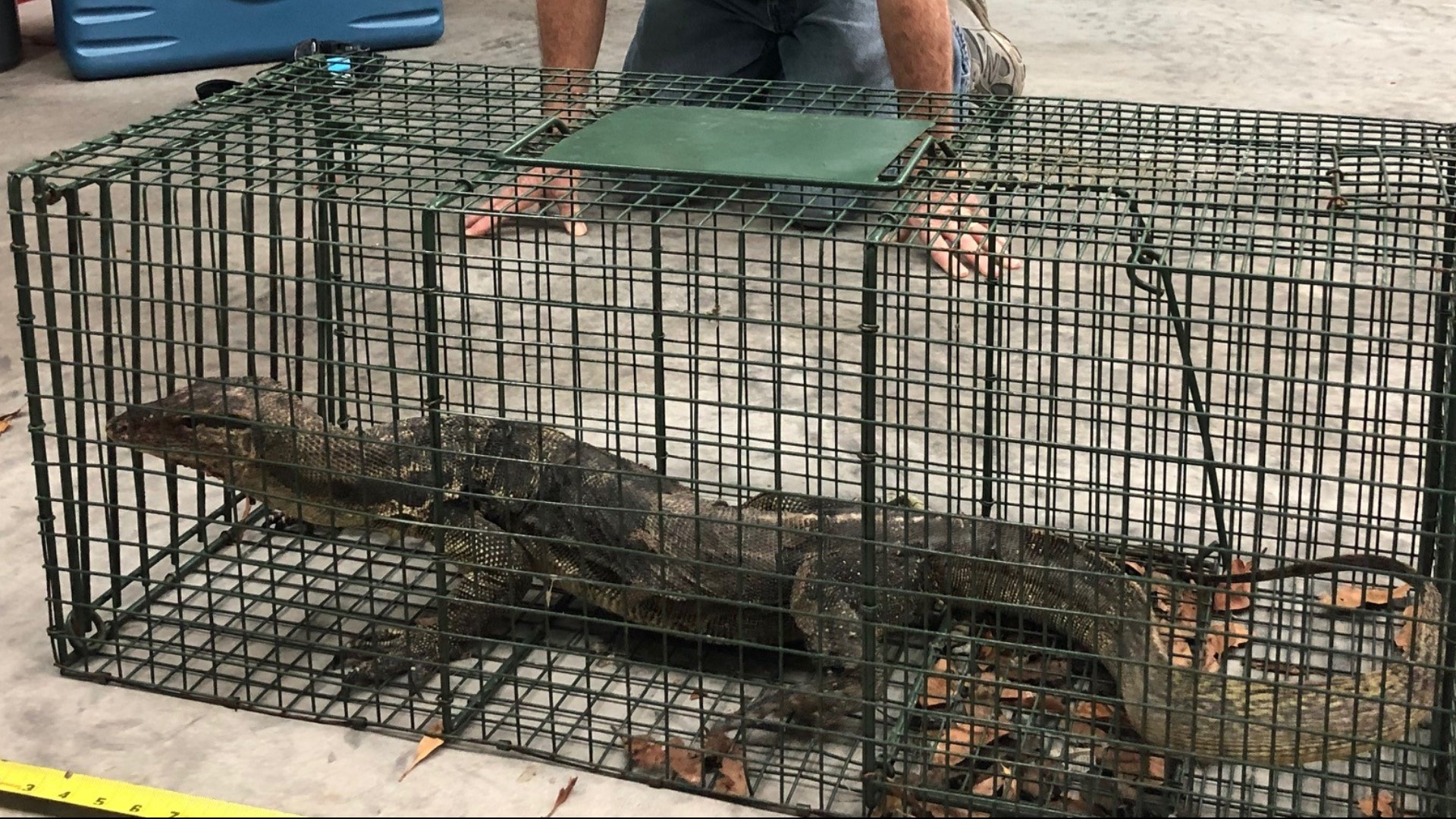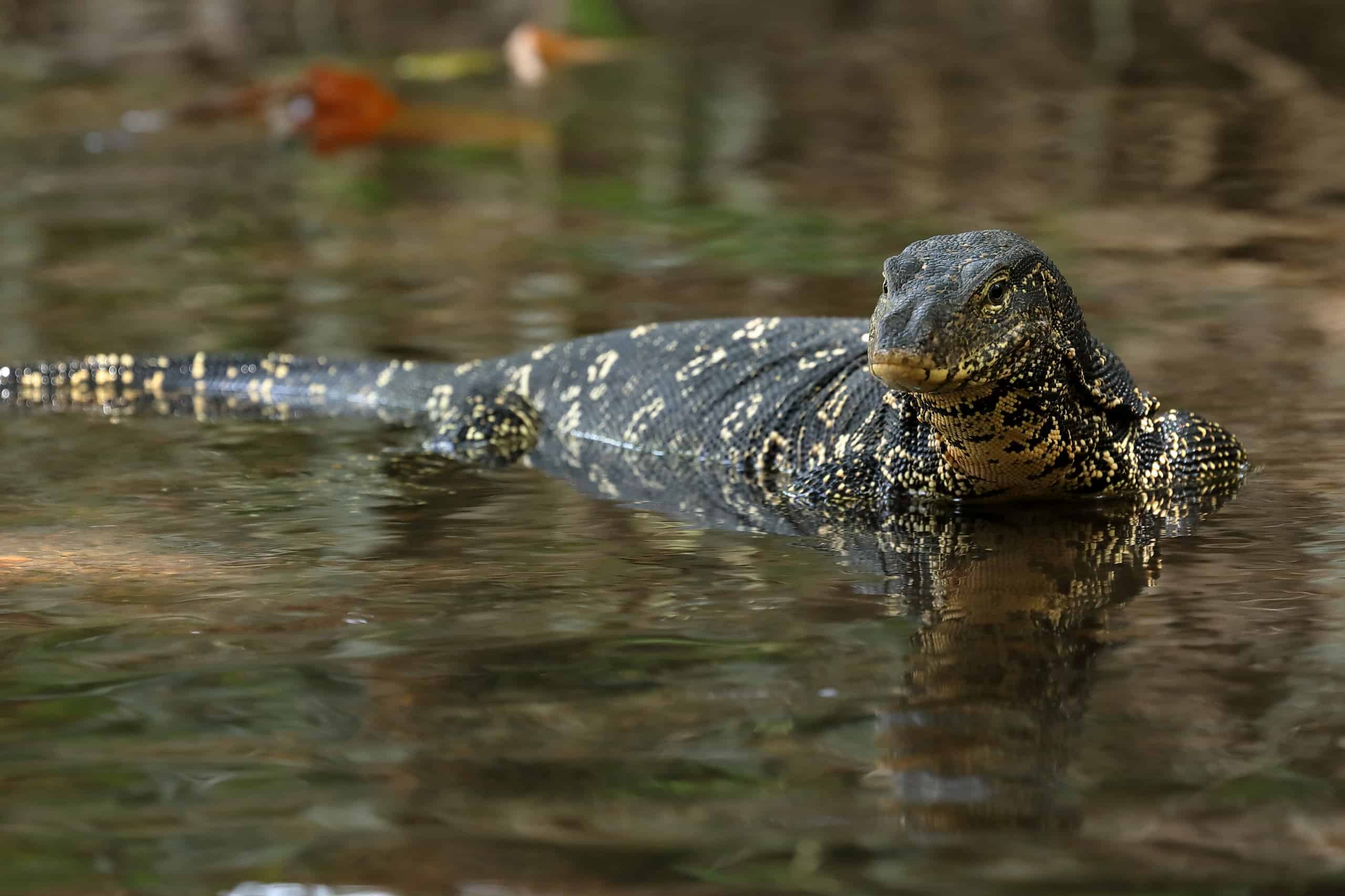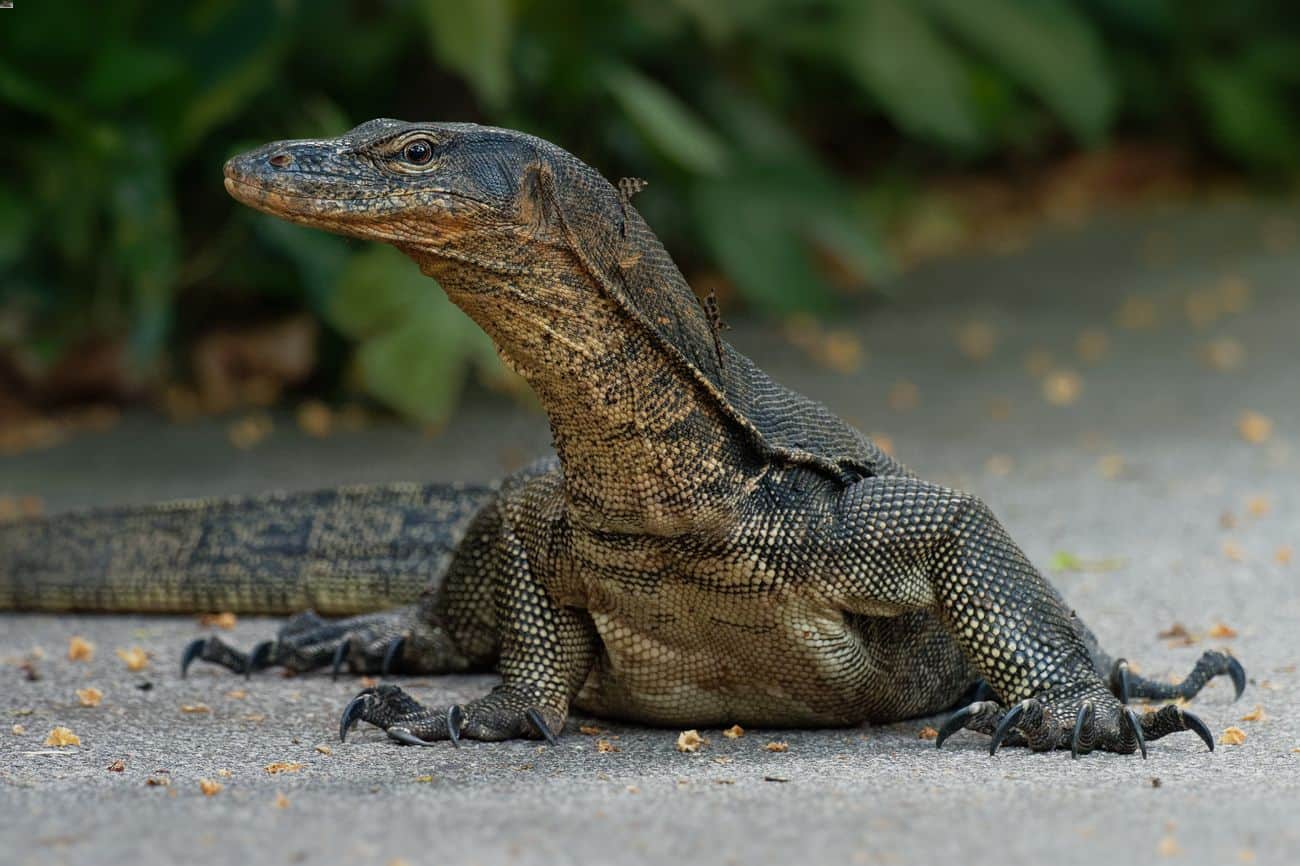Asian Water Monitor Description

Asian water monitors are formidable reptiles that have established a presence in Florida’s ecosystem. Their robust bodies, covered in thick, keeled scales, can reach impressive lengths, with some individuals exceeding six feet. The head is triangular, with a blunt snout and powerful jaws lined with sharp teeth. The tail is long and muscular, serving as a counterbalance during swimming and a formidable weapon when threatened.
Habitat
Asian water monitors prefer warm, humid environments near bodies of water, such as swamps, marshes, and rivers. They are adept swimmers and spend a significant portion of their time in the water. They also utilize burrows, logs, and dense vegetation for shelter and thermoregulation.
Diet
These opportunistic predators have a diverse diet that includes fish, amphibians, reptiles, birds, small mammals, and carrion. They are ambush predators, lying in wait for unsuspecting prey before launching a swift attack. Their powerful jaws and sharp teeth enable them to crush bones and consume prey whole.
Behavior, Asian water monitor florida
Asian water monitors are generally solitary creatures, except during the breeding season. They are territorial and may defend their territory aggressively against conspecifics. They are also known to be inquisitive and may approach humans out of curiosity, but it is important to remember that they are wild animals and should not be approached.
Adaptations for Survival in Florida’s Ecosystem
Asian water monitors have several adaptations that have allowed them to thrive in Florida’s subtropical climate:
– Their thick, keeled scales provide protection from the elements and predators.
– Their powerful tails aid in swimming and serve as a defensive weapon.
– Their ability to tolerate a wide range of temperatures allows them to survive in Florida’s fluctuating climate.
– Their opportunistic diet enables them to exploit various food sources in the diverse Florida ecosystem.
Impact on Florida’s Environment: Asian Water Monitor Florida

Asian water monitor florida – The introduction of Asian water monitors to Florida has had a significant impact on the state’s ecosystem. These non-native predators pose a threat to native wildlife, including birds, reptiles, and small mammals.
Asian water monitors are opportunistic feeders that consume a wide variety of prey. They have been known to prey on native species such as the American alligator, the American crocodile, and the Florida panther. In addition, Asian water monitors compete with native predators for food and habitat.
Challenges and Opportunities for Management
The management of Asian water monitors in Florida is a complex challenge. These animals are highly adaptable and have a high reproductive rate. In addition, they are difficult to capture and remove from the wild. However, there are a number of steps that can be taken to reduce the impact of Asian water monitors on the state’s ecosystem.
- Public education: Raising awareness about the threat posed by Asian water monitors can help to reduce their impact on the environment. People can be encouraged to report sightings of these animals to the authorities and to take steps to prevent them from entering their property.
- Habitat modification: Modifying habitats to make them less suitable for Asian water monitors can help to reduce their population. This can involve removing dense vegetation and creating barriers to prevent them from accessing waterways.
- Trapping and removal: Trapping and removing Asian water monitors from the wild can help to reduce their population. However, this is a difficult and time-consuming process, and it is not always effective.
Human Interactions and Safety

Asian water monitors are powerful predators, and interactions with humans can be dangerous. However, by following a few simple guidelines, it is possible to minimize the risk of conflict.
First, never approach an Asian water monitor. These animals are shy and easily startled, and they may attack if they feel threatened. If you see an Asian water monitor, give it plenty of space and allow it to move away on its own.
Second, never feed an Asian water monitor. Feeding wild animals can lead to them becoming habituated to humans, which can increase the risk of conflict. If you see an Asian water monitor in an urban area, do not attempt to feed it. Instead, contact the local wildlife authorities.
Third, be aware of your surroundings. Asian water monitors are often found in areas with water, such as lakes, rivers, and canals. If you are swimming or wading in an area where Asian water monitors are known to live, be aware of your surroundings and take precautions to avoid being bitten.
Asian water monitors can be a beneficial presence in urban areas. They help to control rodent populations, and they can also be a source of food for other animals. However, it is important to remember that these animals are wild predators, and they should be treated with respect.
Legal and Ethical Considerations
The legal and ethical considerations related to the management of Asian water monitors are complex. In some areas, these animals are considered to be invasive species, and their presence is regulated by law. In other areas, Asian water monitors are protected by law, and it is illegal to harm or kill them.
When managing Asian water monitors, it is important to consider the potential risks and benefits of their presence. In areas where these animals are considered to be a threat to human safety or property, it may be necessary to remove them. However, in areas where Asian water monitors are not considered to be a threat, it is important to allow them to live in peace.
The Asian water monitor, a formidable lizard native to Southeast Asia, has established a foothold in Florida’s delicate ecosystem. Amidst concerns over their impact on local wildlife, the state’s governor has recently signed into law a controversial bill known as the “desantis hoa bill”.
While this legislation primarily addresses homeowners’ associations, it has sparked discussions about the need for responsible pet ownership and the preservation of Florida’s unique natural environment, including the Asian water monitor’s newfound presence.
In the tranquil waters of Florida, the Asian water monitor, a formidable reptile, prowls in search of prey. Its keen eyes scan the surroundings, ever vigilant. Just as discerning is the scrutiny of those who admire the exquisite Hailey Bieber engagement ring , a symbol of love and commitment.
Like the Asian water monitor’s watchful gaze, the ring’s brilliance captures attention, leaving an unforgettable mark on the hearts of all who behold it.
The Asian water monitor is a large lizard native to Southeast Asia. It is a member of the family Varanidae, which also includes the Komodo dragon. The Asian water monitor is a powerful predator that feeds on a variety of animals, including fish, frogs, birds, and small mammals.
In recent years, the Asian water monitor has become established in Florida, where it is considered an invasive species. The lizard has been linked to the decline of native wildlife populations, and it is also a threat to humans. For more information on name changes, visit shiloh name change.
The Asian water monitor is a serious threat to Florida’s ecosystem, and it is important to take steps to control its population.
In the swamplands of Florida, the Asian water monitor, an invasive lizard species, has established a foothold. Its voracious appetite threatens native wildlife. Yet, amidst this ecological concern, a glimmer of hope emerged from an unexpected source: Darren Waller and Kelsey Plum.
Their off-court relationship, as detailed here , has inspired a movement to protect Florida’s delicate ecosystems. By raising awareness and advocating for conservation efforts, they have reminded us that even in the face of invasive species, the spirit of resilience and the power of human connection can prevail.
The Asian water monitor, an invasive species wreaking havoc in Florida’s ecosystem, has found an unlikely ally in the CEO of Chipotle. Brian Niccol, known for his innovative approach to fast food, has pledged to use the chain’s resources to combat the growing threat posed by these formidable predators.